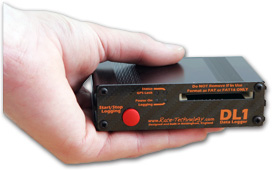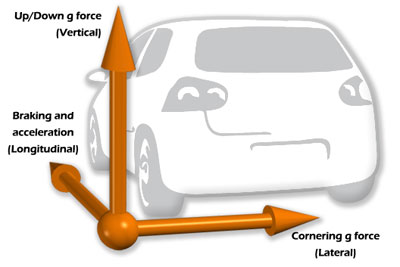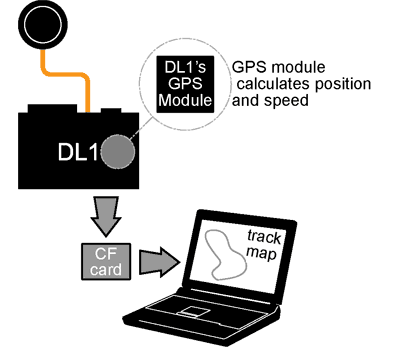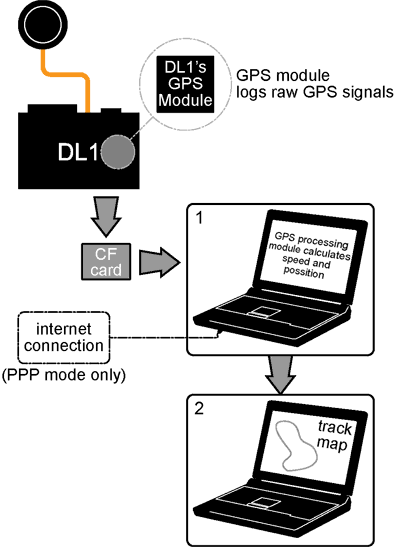DL1

The DL1 is a state of the art, highly robust,
compact "black box" data logging system. Put in the simplest terms,
it stores a wide range of vehicle data for later analysis on a
computer - the system does not include an in-vehicle display,
although there is provision to add this in the future.
The DL1 is suitable for use in cars, boats and on
bikes. The DL1 is also widely used in industrial testing.
Cutting edge features of the DL1 include: Built in
5Hz GPS receiver, digital 3 axis accelerometers, compact flash
memory, 8 12bit analogue inputs, dual RPM inputs, 4 wheel/shaft
speed inputs, lap beacon input, serial input for ECU/OBDii data
(with suitable adapter), output to drive a dashboard, video overlay
system or a telemetry link (options).
There are a variety of accessories available for the
DL1 such as a remote start/stop button, compact flash cards and
compact flash card readers.
Who is the DL1 designed for?
The DL1 was initially designed for autosport
applications including drag racers, single seater racing cars, rally
cars or road cars - however it is also ideal for use on power boats,
go karts and motorbikes. It is also a high quality platform for use
in the auto industry for car testing of all types, from long term
monitoring to competitor benchmarking.

What does the DL1 do?
The DL1 can store data from a number of sources
including its built in high accuracy GPS and accelerometers, wheel
speeds, shaft speeds, engine speeds, temperatures, pressures, lap
times, sector times etc. The DL1 comes packaged with the excellent
Race Technology data analysis package for Windows. The software
allows super accurate track mapping, user defined channels, powerful
graphing and allows direct comparison of up to 10 data sets (races)
simultaneously with almost unlimited laps.
Why use GPS?
One of the key features of the DL1 is its built in high accuracy
GPS system - this gives the DL1 advantages over other data loggers
in 2 key areas - greatly improved track maps and far more accurate
speed measurement.
Track Mapping. Conventional data loggers require a "closed
circuit" to enable them to calculate the track map; the shape of the
track is estimated from a combination of the lateral acceleration
and speed. This works adequately in some situations but it becomes
increasingly inaccurate for long tracks and impossible for open
circuits, motorbikes or boats. In contrast, the GPS will produce
high accuracy track maps in almost any situation.
Speed Measurement. While speed is probably the most important
parameter that anyone wants to measure using the data logging
system, it is also the most inaccurate in a "conventional" system.
The normal way to measure speed is to simply attach a pickup to a
wheel to detect how fast it is rotating - but the rolling
circumference of a tyre changes by 4% just with wear and
temperature. Even worse, the error increases significantly under
race conditions where the tyre is under load - typically the tyre
slips by up to 20% under hard braking going into a corner. Measuring
speed using GPS is now common practice in high-end systems - under
typical conditions speed error is well under 1%!
Features of the DL1 data logger
The DL1 is an all-new, 2nd generation, data logger system from
Race Technology. Whilst the DL1 builds on the strengths of our
highly successful DL90 system, it is a brand new design in almost
every respect. Some of the most noteworthy features include:
- Built in GPS. The new GPS unit is based on our own high
accuracy GPS3 technology and calculates position and speed 5
times every second. This is easily the fastest, most accurate
GPS system available for under $1500. The measurements from the
GPS and accelerometers are combined to calculate very high
accuracy positions and speeds at 100 times a second.
- Built in accelerometers. Built in 3 axis accelerometer with
2g full scale (optional 6g full scale).
- Logging to compact flash memory. Compact flash memory is
robust, economical and ideal for use in data logging products.
The advantages of using compact include incredibly fast download
times (using a suitable card reader) and huge storage
capacities.
- 8 analogue inputs. The DL1 has 8 very high accuracy analogue
inputs. All the inputs are 12-bit accuracy (4096 different
levels) and have a maximum input of 12v
- 2 RPM inputs, only one of which can be used at any one time.
One input is designed to be connected to "high level" sources,
such as the HT leads (via capacitive pickup) or the ignition
coil. The other input is designed for low level signals such as
a feed from the ECU.
- 4 wheel/shaft speed inputs. The DL1 features 4 totally
independent wheel/shaft speed inputs. These can be used to
measure the speed of all four wheels, or slip ratios across a
torque converter for example.
- Serial data (RS232) input. The serial port can be configured
to accept data from an external source - possible examples are
data from the engine management unit, OBDii or CAN data (with a
suitable adapter)
- Serial data (RS232) output. As well as logging the data to
compact flash it is also available from the serial port. We are
already working on a dashboard which will accept and display
this data.
- Marker input. For some applications it is desirable to have
direct track marker input, so we have included a dedicated input
for it.
- Small and tough. It's the most compact logger in its class,
at just 110mm x 75mm x 30mm (4.3" x 3" x 1.2") it can be fitted
into the smallest single seater, motorbike or go kart. The DL1
is housed in a 2mm thick aluminium enclosure and carbon fibre
end panels for very high impact resistance, we even use
stainless steel screws!
- Simple operation. A single button to start or stop logging,
it's as simple as that! If the button is inaccessible from the
drivers seat then a remote button and status indicator can be
added if required.
- Power supply requirements. The power supply to the DL1 data
logger can be taken directly from the vehicles 12v supply, or it
can be powered from it's own battery if required. The power
supply is smoothed and regulated within the DL1 ensuring its
performance is highly robust and stable.
- Testing. Very high reliability is ensured by calibrating,
temperature testing and vibration testing each unit on an
individual basis. Autosport applications make tremendous demands
on electronic systems and we take great care to make sure our
products are up to the task. All the connections to the units
are vibration proof, high strength to ensure that connections do
not fail at the critical time. Nothing is indestructible - but
the DL1 comes close!
- Powerful. The 2 processors in the DL1 are the very latest
generation RISC processor that features both higher speed
operation and flash upgradability - so as we add new features to
the DL1 you can upgrade yours to the latest specification for
free.
A complete DL1 data logging
system, ready to use. Includes:
- DL1 unit
- Magnetic mounting GPS antenna (3m cable)
- 1 pair of aluminium brackets
- 4 velcro strips
- 2m serial lead (null modem)
- 12v power lead (with connector block)
- Comprehensive software CD
- Carrying case (with cut foam interior)
- DL1 Quick Start Guide
The only thing you will need to add is a compact flash
card and a suitable card reader for your PC, to download and
analyse data.
|
Available preloaded with the following options:



|
| Add-On
Options

The DL1 features a very high quality 3 axis
accelerometer to measure:
- braking and acceleration g force
(longitudinal acceleration)
- cornering g force (lateral acceleration)
- up/down g-force (vertical acceleration)

The maximum g force that can be measured in any
axis with a standard DL1 is 2g, this is enough
for most racing applications where there are
no significant aerodynamic aids.
For applications with underbody downforce, large
wings etc then the 6g option is
recommended. |

The 20Hz GPS option for the DL1 is quite simply the best
and most accurate available of any competitor data logging
system. The GPS makes a unique calculation of position and
speed 20 times a second with no interpolation or other
"tricks".
The unique GPS technology has been developed in house by
our engineers and tested in the most challenging racing
environments - the accuracy is nothing short of a break
though at this price point and in this respect there really
isn't any competition.
The diagram below illustrates how the standard 5Hz DL1
processes GPS data, internally:

With the 20Hz option (shown below) the DL1 logs only the
raw GPS data and uses the processing power of the computer
to calculate speeds and positions. It is the processing
power of the PC and the calculations applied to the data
that makes real improvements.

There are 2 modes that the GPS system can be used in:
- Standard 20Hz mode. In this mode the raw GPS
data is logged from the GPS module in the DL1, and when
you process the data the raw GPS measurements are
converted into speeds and positions etc
- Advanced PPP 20Hz mode. This is a more
advanced processing mode that downloads GPS corrections
from the internet before processing the data. This
results in even better positional accuracy! This mode
obviously requires that the PC is connected to the
internet at the time that you process the data.
There are a few important things to note about the 20Hz
options:
- Some of our competitors (no doubt jealous of our
unique technology) claim that our GPS is not really 20Hz
in some way. This is simply rubbish, we wrote the code
in house and absolutely guarantee that this is a genuine
20Hz system without any caveats whatsoever.
- The main benefit of this GPS system doesn't really
come from the fact that it is 20Hz, this is simply a
measure of the number of measurements that are taken
every second. The key to the systems performance is in
the maths that is used to make the calculations - using
the processing power of the PC to calculate the GPS
position/speed we are able to make some real
improvements. Even if we were only calculating the
updates 5 or 10 times a second then our GPS technology
would be superior!
- Typically the 20Hz option won't improve "poor" GPS
data, it will make good GPS data even better. The
situation is the same with the PPP option, this doesn't
correct for a poor GPS lock, but instead just improves
an already good data set. You must still mount the GPS
antenna correctly to get good GPS accuracy.
- Note that due to licence restrictions, the 20Hz GPS
data will have its resolution limited when you export it
to an external application. The full GPS speed/position
resolution will only be available in the analysis
software. Exported data will have a resolution of 1m/s
and 2.5m for speed and position respectively.
|

DL1 + drift option.
This option uses a very high accuracy gyro that is built into the
DL1 to measure the way that the car is pointing and compares this
with GPS data that measures which way that the car is traveling.
Taking one from the other allows us to measure the drift angle of
the vehicle.


To see the included Race
Technology Data Analysis Software click here.
List Pricing:
DL1 $859.00
DL1 +6g Accelerometer $959.00
DL1 +20HZ GPS $1109.00
DL1 +Drift $1179.00
DL1 +20HZ GPS & +6g Accelerometer $1209.00
To place an order please Contact Us
Ask about our 10% Holiday Discount!
Click here to see the full line of
Race-Technology Data Logger and Display Units
|
